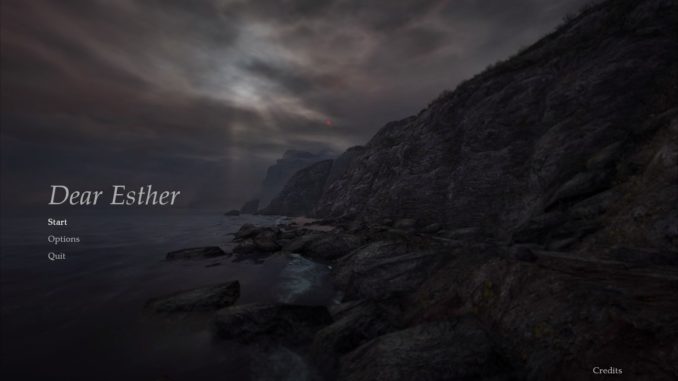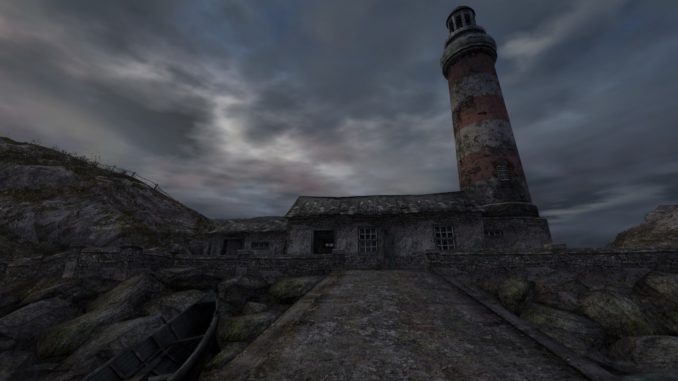
Dear Reader,
I’m writing to you today for I wonder at the thoughts you would think, and the words you would utter, if you could see what I have seen. Hear what I have heard. And experience what I have experienced. Would your thoughts and opinions mirror mine as Narcisuss’s visage was reflected back to him from the water of a pool?
Or will my thoughts be as a cherry blossom falling to the ground? Seen, but lost among the countless number of facsimiles. Remembered for a second, but forgotten and swept away for all eternity.
I wonder…

Dear Esther is an interesting experiment. It is a game devoid of action, violence, sex, interaction, and characters of any kind. You are on a deserted island devoid of life with a voice reading to you from a letter as you explore the island. No more and no less.
Or so it would seem.
As I wandered throughout the island, the voice read excerpts from a letter to a woman named Esther. Over time I began to wonder about Esther, the voice, and two men named Donnelly and Jakobson. All are mentioned frequently throughout the game yet there is much that requires explanation.
The game uses Valve’s Source engine and, despite the engine’s age at this point, looks picturesque. The island might be devoid of life but the views are lovely if somewhat grim. As I made my way to a lighthouse I saw rolling hills of grass, walked along a beach, spotted derelict ships beached upon the shore, and many other sights. There was also a section of the game where I found myself in a cave which took my breath away. Stalactites, stalagmites, glowing objects, gems, and waterfalls made this section easily one of my most remembered locations for a video game.

During my exploration of the island I would trigger random readings from a letter read to me by a nameless voice that is, presumably, Esther’s husband. The voice, along with the music and setting, creates a great atmosphere for the game. Because of the ambience that was generated, I found the island somewhat eerie and the letter and musical selection despondent most of the time. These two components are critical to Dear Esther and flesh it out so much.
Jessica Curry did a great job with the game’s music which really helps to bring it to life. From piano pieces to orchestrated selections the soundtrack is memorable and left quite an impression on me (I purchased it after playing the game). The same goes for Nigel Carrington who is the one reading the letter. His delivery of the letter’s content is superb and, with all of these elements combined, transforms the setting of Dear Esther into a memorable one.
Yet this is a game like no other. All you do is explore the island and listen as the fragments of the letter are read to you. You don’t interact with any objects and you don’t even open doors. There is no puzzle solving, no great quest to complete, and no villain to thwart. Just you on an island walking around and listening to the voice.
And when I mean walking, I do mean walking. There is no running and no jumping; just walking at a normal pace as you wander around the island. This, of course, can be a little irritating at times because certain paths you take will end up being a dead end and you will have to walk back. Several times I found myself wishing there was a run button assigned so I could quickly backtrack to the other path so I could continue exploring and hearing excerpts from the letter.

Aside from dead ends and walking, the entire game is also rather short. Dear Esther can be completed anywhere from one to two hours. Retailing for $10 this might seem rather steep for a two-hour game but considering that you can pay the same price to see a movie at the cinema it isn’t that big of a deal.
In any case, you can replay the game by taking different paths and hearing different excerpts from the letter that you will not have heard on your first playthrough. There are also objects and signs you will see throughout the game that might give you a better understanding of the events regarding Esther and her husband.
All in all, I found Dear Esther to be an intriguing, emotional, and thought-provoking game. It has been a long time since a game has made such an impact on me. I didn’t yell out in triumph or grin from ear-to-ear at a happy ending. Instead, I found myself contemplating about the game and what had transpired in it.
This is certainly not your typical game in any sense of the word. But for a game where all you do is walk around and listen to someone read you a letter, it is brilliant.
Tested on PC
9/10
Author’s Note: This review was originally written and posted on Press2Reset in February 2012. Sadly, the website went through a new redesign and all of my work there is no longer available. Thankfully, I still have most of my editorials and reviews so I can repost them on here.
Support this site by donating via Paypal or even checking out our merchandise on RedBubble where you can find designs that cater to writers and readers. Money donated and raised goes into paying for this website and equipment.






